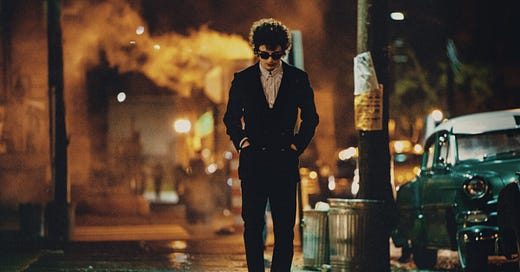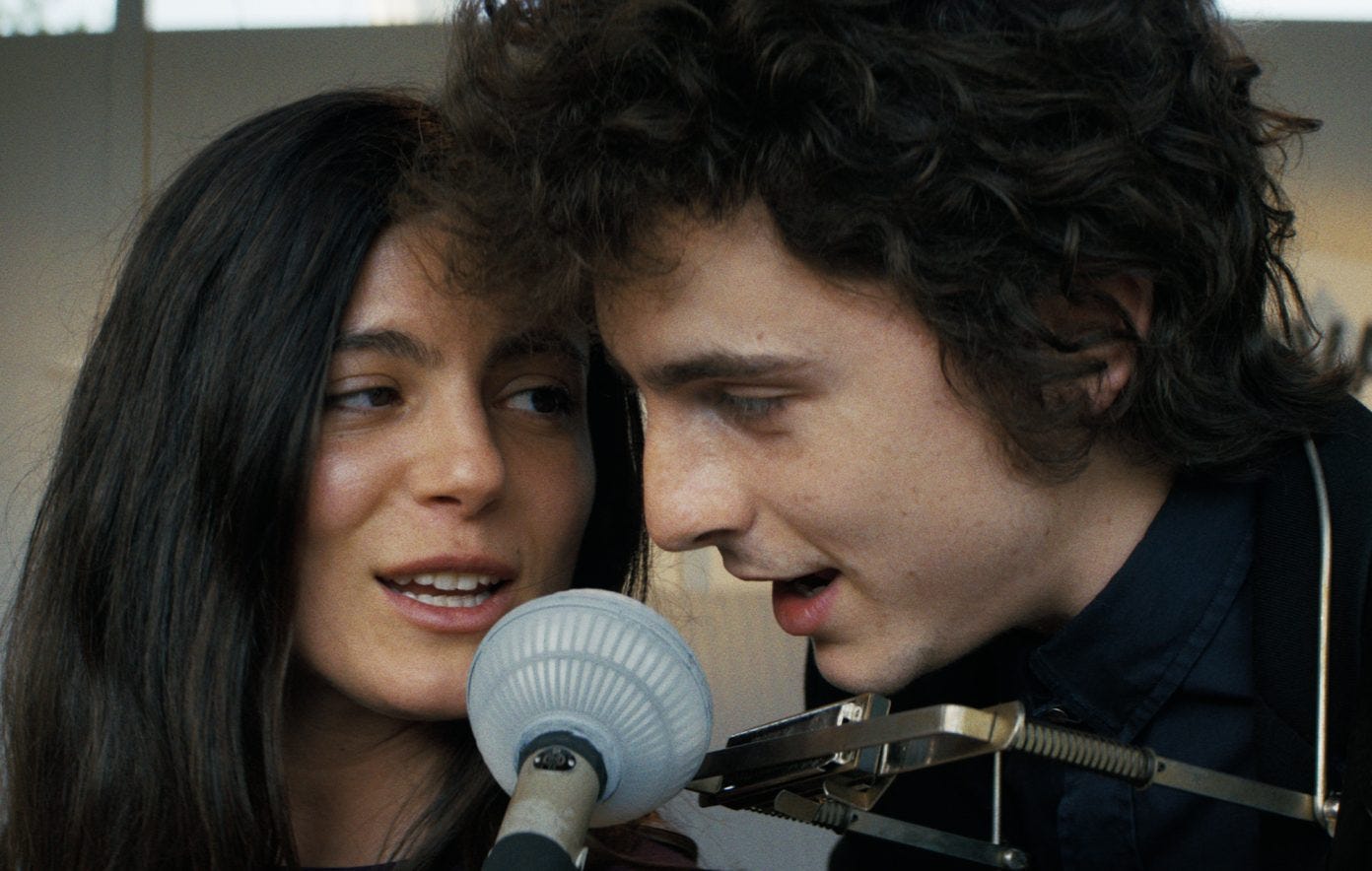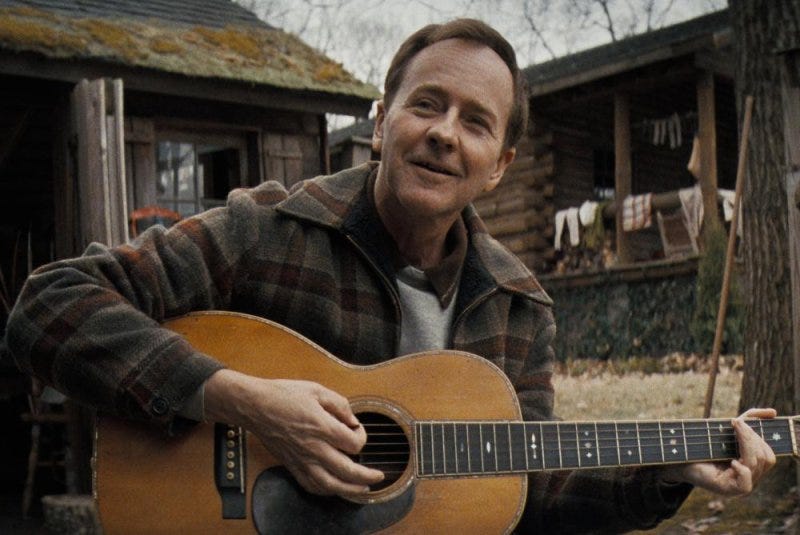A Complete Unknown (2024)
Timothée Chalamet uncoils folk legend Bob Dylan slithering into music history
A Complete Unknown (2024)
In theaters beginning December 25
In popular parlance this production has come to be referred to as “that Bob Dylan movie”. Certainly no one over age 30 imagines it’s a full-blown biopic of the long, circuitous career of songwriter-singer Bob Dylan (born 1941). For decades that enigmatic Mr. Plainspoken of American music has adopted shifting guises.
I’ve never been inclined to keep track of them. Hearing Dylan’s raspy oracular voice was enough to keep him hanging around in my head. Since in one of his most resonant songs he declared that the answer to life’s most painful ironies was “Blowin’ in the Wind” (1963), I didn’t imagine the man himself would be easy to pin down.
Smartly, director James Mangold and co-screenwriter Jay Cocks haven’t tried to decode his expansive career.
Instead, the filmmakers have focused on the idol’s formative years, from his 1961 immersion into the Greenwich Village folk music scene to his career-shifting appearance at the Newport Folk Festival in 1965, when the hypnotic guitarist and harmonica player controversially went electric.
We meet him (Timothée Chalamet) as a 19-year-old Minnesotan arriving in New York hauling his guitar like a talisman.
In the lives of artists, invariably those who become idols first genuflect before those they’ve idolized. Thus, Dylan seeks out the ailing Woody Guthrie (Scoot McNairy, in a wordless but moving performance).
The legendary folk artist lays ill in a New Jersey veterans’ hospital fighting Huntington’s disease, able to speak only with a few low guttural words.
He’s tenderly attended by another beloved folk singer, Pete Seeger (Edward Norton). Seeger is a sort of associate idol who’ll introduce Dylan to the Village folk music scene and help nurture him.
The boy bard sings the tender “Song for Woody” for the two masters of the genre, having acknowledged he’s itching to make a mark in folk music. His first scratch is in this hospital room, and Guthrie becomes a north star Dylan will revisit when he needs to touch his roots again.
This is unabashedly a movie for rapt Dylan listeners of all ages, though I’d imagine closer students of his oeuvre than I may want more from the decidedly minimalist script.
That’s reasonable but it misunderstands what’s being attempted here. The screenplay’s modest agenda is what I most admire about it. Its get-to-the-point scenes leave us in delight, puzzlement or both.
The story then briskly moves on. Just like Dylan. We’re not going to get the whole man. He moved fast and broke expectations.
Making a splash on the Village folk scene — the New York Times calls him “a cross between a choirboy and a beatnik” — he dives into a relationship with Sylvie Russo (Elle Fanning). She’s a non-musician who admires his talent but is keenly aware of the changing world.
Sylvie points to the Cuban missile crisis, the expanding civil rights movement and the assassination of JFK to wake up Dylan. She pushes him to write not just about what’s in his head but about a society undergoing pivotal change. She may be one reason he eventually produced “The Times They Are A-Changin’” (1964).
Joan Baez (Monica Barbaro) and Dylan harmonize in the spotlight and clash offstage
As the bard slowly turns into an ambitious music gadfly, Dylan also does some sexual sniffing around. Still hooked up with Sylvie, he plunges into a relationship with the beautiful Joan Baez (Monica Barbaro), already a world-famous folk singer who isn’t so easily taken in by Dylan’s country boy balladeer image.
Baez also sees the hustler inside the raw “innocent”. Dylan the rising star sees in Baez the folk avatar (she’s already appeared on the cover of Time magazine) he can’t help wondering whether he could be, too.
They bicker and goad one another, she records some of his songs, they share stages across the country, they can’t figure out what they mean to one another. No idyllic ending. This is yet another true-life Dylan mystery the script leaves us to ponder.
Where is Dylan headed musically? That crucial career turn is the movie’s fulcrum, the shift from mesmerizing writer, singer and performer to folk iconoclast, aural poet to artist whose deep counterculture impulse is still felt today.
To see that his impact sticks, electric instrumentation calls to him, and he’s determined to tackle the new sound head on.
Agent to both Dylan and Baez, Albert Grossman (Dan Folger) urges him to think carefully about expanding his musical reach. The now best-selling singer’s lucrative contract with Columbia Records could be jeopardized if his fanbase rejects a non-acoustic Dylan sound.
But fellow bad boy Johnny Cash (a terrific Boyd Holbrook) urges him to “make some noise” and “dirty up the carpet” of an overcautious folk tradition.
There wasn’t one song Chalamet performed that I didn’t want to go on longer. You feel in his vocal reach a hunger and a raw power, while the songwriter’s terse lyrics never over-insist. His voice makes you wonder what’s churning inside Dylan behind those dark glasses.
The showdown comes at the 1965 Newport Folk Festival at a July Sunday-night concert. Dylan has barely scraped together all the electric instruments the band needs and one of his players arrives late. He’s not entirely sure he’s going to make the move until he goes on stage.
Then he rips into versions of “Maggie’s Farm” and “Like a Rolling Stone”, furiously thrumming his Fender Stratocaster electric guitar, and you feel rage and release pouring out of him. The next phase of the Dylan legend is underway.
Mangold and company have given us the starting point, the launching pad to a career that would soar for decades and eventually see Dylan awarded the Nobel Prize for Literature, the only songwriter ever to have won that honor.
The director and his cinematographer Phedon Papamichael keep the gritty folk scene details, in the Village, on the road and at Newport, absorbingly period correct.
The jolt of a blooming cultural movement is captured without fussiness. The smoky nightclubs and grueling recording sessions are evocative without being nostalgic. The meticulously lit shots urge you to look hard, not merely look backward in time.
The performances are in a similarly plain, unadorned style. Barbaro makes an entrancing Baez, whose beautiful, lulling voice distills an emotional purity distinct from Dylan’s. He’s growly winter, she’s summer rain.
Peter Seeger (Edward Norton), a folk music traditionalist, welcomes the iconoclastic Dylan
Norton nicely depicts Seeger’s avuncular care for Dylan’s budding genius and the actor also plays a sparkling banjo. Both Norton and Barbaro perform their songs with an exciting live-action verve.
Holding it all together is Chalamet’s brooding Dylan. The actor gets the musician’s head held downward, day or night sunglasses and hobo stroll down cold. He’s fun to watch.
We see the hunger and the devil-may-care brusqueness of a Dylan still looking for his life’s mission. He’s sometimes rude, a less than devoted lover and a brash writer-instrumentalist who won’t let the musical establishment, even when it claims to be anti-Establishment, corral him.
Chalamet sings more than 20 Dylan songs, all live. He’s explained that he assiduously studied voice, guitar and harmonica during the five-and-a-half years it took to get this script into production.
There wasn’t one song he performed that I didn’t want to go on longer. You feel in his vocal reach a hunger and a raw power, while the songwriter’s terse lyrics never over-insist. His voice makes you wonder what’s churning inside Dylan behind those dark glasses.
In his evolving career Chalamet (he turns 29 on December 27) has now scaled twin acting peaks. In Call Me by Your Name (2017) he showed an aching vulnerability that left his character and the audience shattered.
Here he smoothly melds unique musical craftsmanship with stubborn self-righteousness. Just as Dylan the renegade refused to rely on trappings and flourishes to seduce listeners.
What nerve both the actor and the troubadour have. That’s this movie’s real electricity.







Of course, this is one that I definitely will catch! (but I might avoid the Christmas rush)